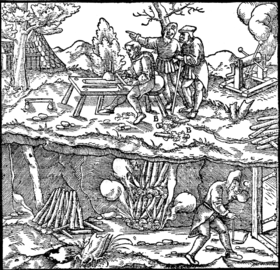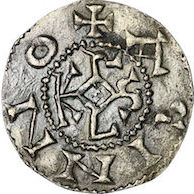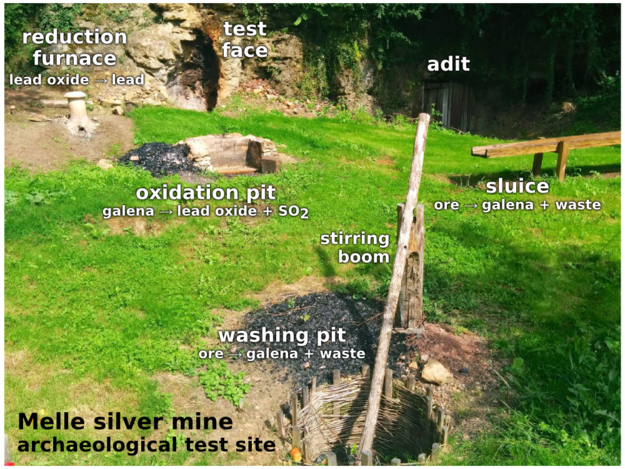Burrowing by burning
/Most kind of mining are low-yield games. For example, the world's annual gold production would fit in a 55 m2 room. But few mining operations I'm aware of are as low yield as the one that ran in Melle, France, from about 500 till 950 CE, producing silver for the Carolingian empire and Charlemagne's coins. I visited the site on Saturday.
 The tour made it clear just how hard humans had to work to bring about commerce and industry in the Middle Ages. For a start, of course they had no machines, just picks and shovels. But the Middle Jurassic limestone is silicic and very hard, so to weaken the rock they set fires against the face and thermally shocked the rock to bits. The technique, called fire-setting, was common in the Middle Ages, and was described in detail by Georgius Agricola in his book De Re Metallica (right; aside: the best translation of this book is by Herbert Hoover!). Apart from being stupefyingly dangerous, the method is slow: each fire got the miners about 4 cm further into the earth. Incredibly, they excavated about 20 km of galleries this way, all within a few metres of the surface.
The tour made it clear just how hard humans had to work to bring about commerce and industry in the Middle Ages. For a start, of course they had no machines, just picks and shovels. But the Middle Jurassic limestone is silicic and very hard, so to weaken the rock they set fires against the face and thermally shocked the rock to bits. The technique, called fire-setting, was common in the Middle Ages, and was described in detail by Georgius Agricola in his book De Re Metallica (right; aside: the best translation of this book is by Herbert Hoover!). Apart from being stupefyingly dangerous, the method is slow: each fire got the miners about 4 cm further into the earth. Incredibly, they excavated about 20 km of galleries this way, all within a few metres of the surface.
 The fires were set against the walls and fuelled with wood, mostly beech. Recent experiments have found that one tonne of wood yielded about one tonne of rock. Since a tonne of rock yields 5 kg of galena, and this in turn yields 10 g of silver, we see that producing 1.1 tonnes of silver per year — enough for 640,000 deniers — was quite a feat!
The fires were set against the walls and fuelled with wood, mostly beech. Recent experiments have found that one tonne of wood yielded about one tonne of rock. Since a tonne of rock yields 5 kg of galena, and this in turn yields 10 g of silver, we see that producing 1.1 tonnes of silver per year — enough for 640,000 deniers — was quite a feat!
There are several limits to such a resource intensive operation: wood, distance from face to works, maintenance, and willing human labour, not to mention the usual geological constraints. It is thought that, in the end, operations ended due to a shortage of wood.
Several archaeologists visit the site regularly (here's one geospatial paper I found mentioning the site: Arles et al. 2013), and the evidence of their attempts to reproduce the primitive metallurgical methods were on display. Here's my attempt to label everything, based on what I could glean from the tour guide's rapid French:
The image of the denier coin is licensed CC-BY-SA by Wikipedia user Lequenne Gwendoline.










 Except where noted, this content is licensed
Except where noted, this content is licensed